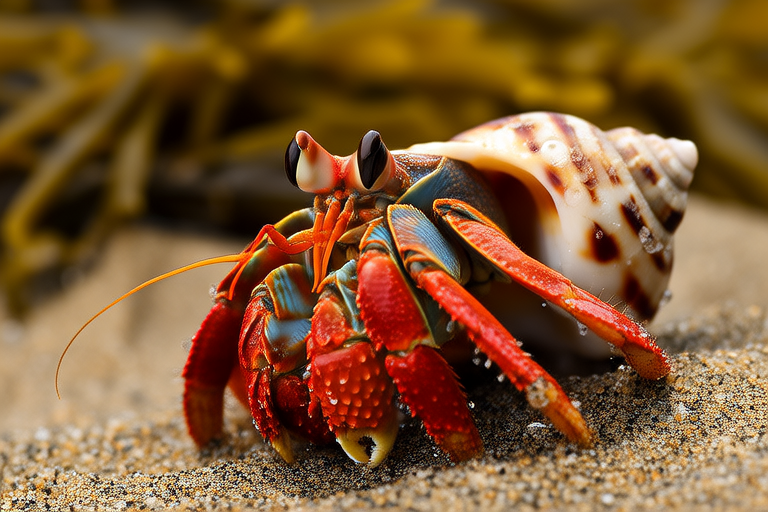Debunking Myths About Hermit Crabs
Hermit crabs are fascinating creatures that have captured the hearts of many pet enthusiasts. However, there are numerous misconceptions surrounding these crustaceans. This article aims to dispel ten common myths about hermit crabs, providing accurate information regarding their habitat needs, dietary requirements, shell-changing behaviors, social interactions, and overall care.
Myth 1: Hermit Crabs Are Completely Self-Sufficient
Myth: Hermit crabs can survive with minimal attention, requiring only occasional feeding and water changes.
Reality: While hermit crabs are hardy creatures, they still require proper care to thrive. They need a balanced diet consisting of protein, vegetables, and fruits. Additionally, hermit crabs must be provided with fresh water for drinking and saltwater for soaking, which helps them maintain their body’s moisture balance. It’s essential to regularly clean their habitat to prevent the buildup of harmful bacteria.
Myth 2: Hermit Crabs Can Live Without a Shell
Myth: Hermit crabs can survive without shells as long as they have other protective structures.
Reality: Hermit crabs rely on shells for protection against predators and environmental elements. Without a shell, they become vulnerable to injury and predation. Owners should provide a variety of shells in different sizes and shapes to accommodate growth and ensure their pets’ safety.
Myth 3: Hermit Crabs Prefer Isolation
Myth: Hermit crabs are solitary animals that prefer living alone.
Reality: Hermit crabs are social creatures that benefit from interaction with others of their kind. In the wild, they often live in large groups near the ocean’s edge. Pet hermit crabs can coexist peacefully when provided with enough space and resources. However, overcrowding can lead to stress and aggression.
Myth 4: Hermit Crabs Can Eat Anything
Myth: Hermit crabs will eat any food given to them, making it easy to care for their dietary needs.
Reality: A well-balanced diet is crucial for hermit crabs’ health. They require a mix of proteins, vegetables, and fruits. Avoid feeding them processed foods, sugary snacks, or foods high in fat. Providing a variety of nutritious options ensures optimal health and longevity.
Myth 5: Hermit Crabs Change Shells Regularly
Myth: Hermit crabs frequently change shells as they grow.
Reality: Hermit crabs typically change shells when they outgrow their current one or find a more suitable option. The frequency of shell changes varies among individuals and depends on factors such as growth rate and availability of appropriate shells. Owners should offer a selection of shells to encourage healthy shell changes.
Myth 6: Hermit Crabs Are Nocturnal
Myth: Hermit crabs are strictly nocturnal and remain inactive during the day.
Reality: Hermit crabs exhibit crepuscular behavior, meaning they are most active during dawn and dusk. However, they may also be active at night or during the day if conditions are favorable. Providing a consistent light cycle and a comfortable environment encourages natural activity patterns.
Myth 7: Hermit Crabs Don’t Need Humidity
Myth: Hermit crabs can survive in dry environments without additional humidity.
Reality: Maintaining appropriate humidity levels (around 70-80%) is vital for hermit crabs’ respiratory systems and overall health. Low humidity can cause dehydration, respiratory issues, and molting problems. Owners should use a hygrometer to monitor humidity and mist the enclosure daily.
Myth 8: Hermit Crabs Are Harmless to Humans
Myth: Hermit crabs are completely harmless and pose no threat to humans.
Reality: While hermit crabs are generally gentle, they can pinch if threatened or mishandled. Proper handling techniques, such as gently scooping them up from behind, minimize the risk of pinching. Additionally, hermit crabs can carry diseases, so regular cleaning and hygiene practices are necessary.
Myth 9: Hermit Crabs Don’t Require Exercise
Myth: Hermit crabs don’t need exercise because they spend most of their time inside their shells.
Reality: Hermit crabs benefit from physical activity, which promotes muscle development and mental stimulation. Providing ample space for exploration, climbing structures, and hiding spots encourages natural behaviors and reduces boredom. Regular exercise contributes to overall well-being.
Myth 10: Hermit Crabs Are Easy to Breed
Myth: Hermit crabs are simple to breed in captivity.
Reality: Breeding hermit crabs in captivity is challenging due to specific environmental and dietary requirements. Successful breeding requires precise conditions, including proper salinity levels, temperature, and diet. Most hobbyists focus on providing optimal care rather than attempting to breed hermit crabs.
Conclusion
Understanding the true nature of hermit crabs helps owners provide the best possible care. By addressing common myths and offering accurate information, we hope to promote responsible ownership and enhance the lives of these unique creatures. Remember, proper habitat setup, nutrition, and attention to detail are key to ensuring your hermit crab remains happy and healthy.
